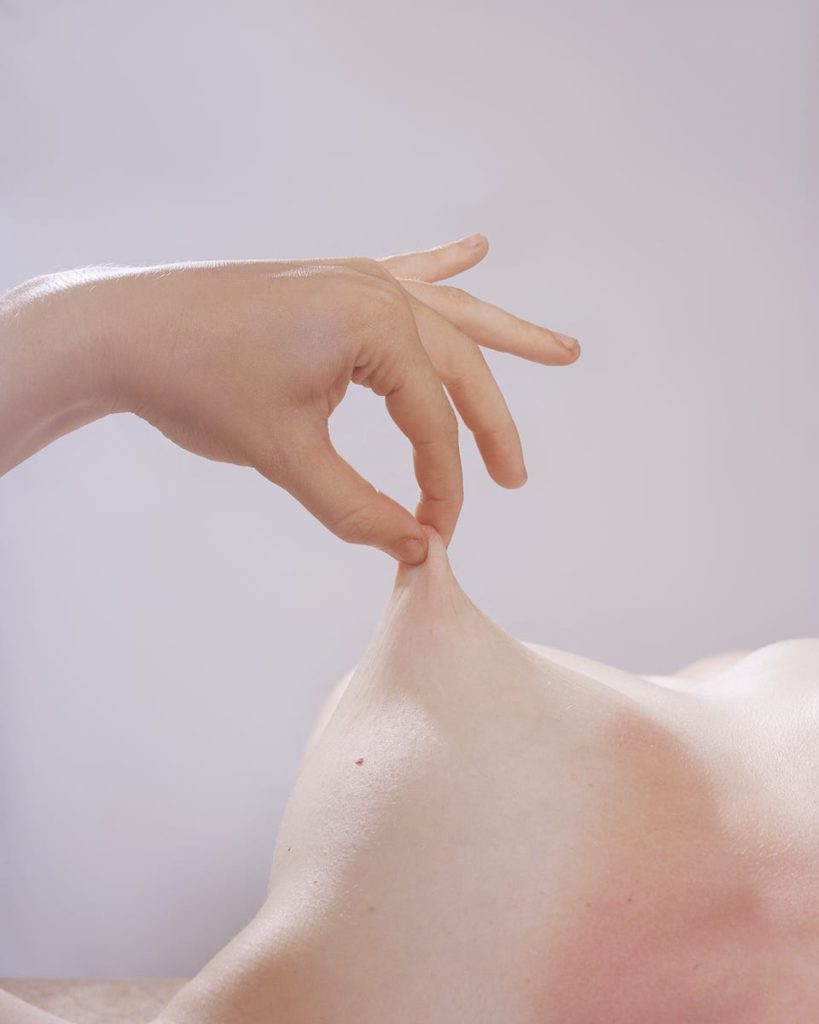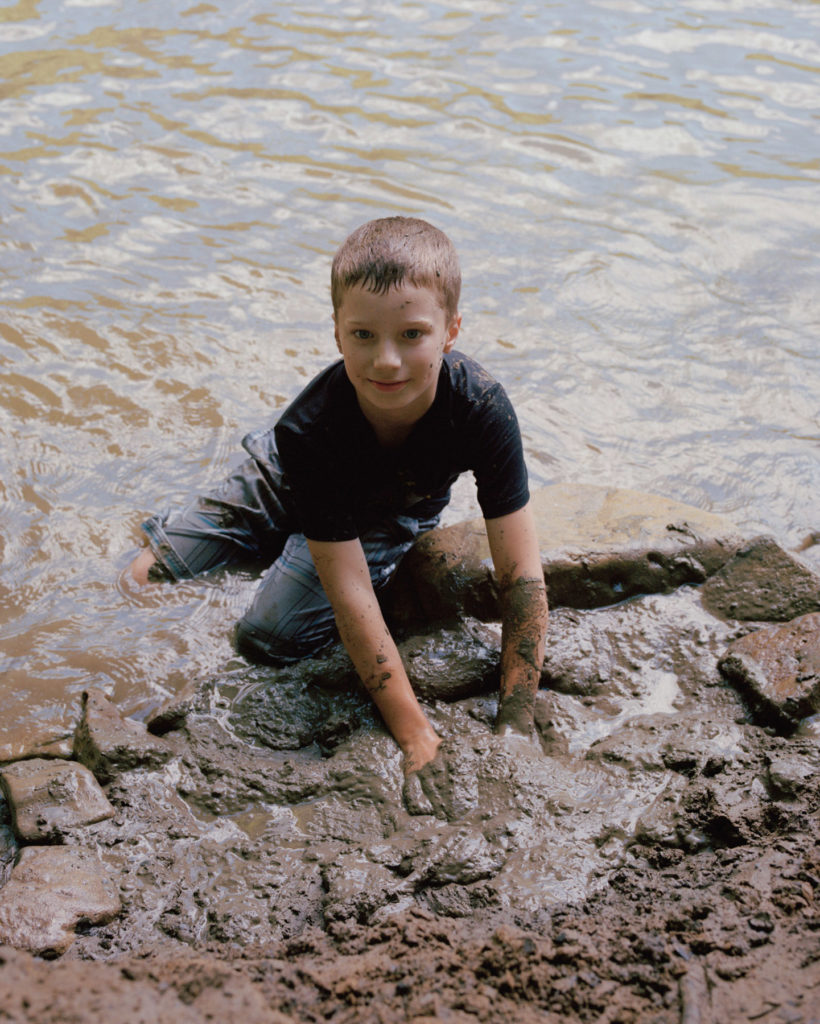Caroline currently lives in Brooklyn, NY. Her photographs explore issues of female sexuality, localism, and sincerity within them. Over the past five years, Caroline Tompkins has been making images of her sexual desires and fears. Her new book, Bedfellow explores the relationship sex has with pleasure and danger.
Looking at your work, I think you’ve certainly taken countless portraits. So instead of asking you about the “very well kept secret” of making good portraits, I’d rather ask when you prefer to do a close up on a person instead of including their face, like in the leech photo for example?
Something I love about photography is that I get to divorce it from my personal life. Yes, that’s a picture of me kissing a boy I used to kiss, but now it’s a picture about intimacy, utopia, ecstasy, etc. I get to boil all of these images down to their most basic symbols. The self portraits aren’t about me. I was just the most readily available subject.
The leech photo in particular was born from an idea I had many years ago. I was in a bad relationship, and I had a recurring dream that I was covered in leeches. I finally looked it up and found the internet telling me to dream of leeches is to have something sucking the life out of you. I’m not someone that gets a lot of inspiration from dreams, but I found myself searching, “leech therapy near me nyc” and contacting them to see if I could trade images for leeches. When my lack of Polish language speaking turned into a lot of deadends, I went to youtube and discovered Leech.com. I bought 9 leeches and found a friend that was willing to have me perform the leech therapy on him.
This all doesn’t really matter. I just like the story. I like that the leeches are nasty and bloody but you can’t look away. You’re harming yourself with the hope of being renewed. Relationships can feel like that too.
In Bedfellow, you create some great contrasts, not in an obvious way, between pleasure and fear in sex, referring to marginal situations. When did you first realise how close these two states can be in life?
It was a gradual realisation over many years. In college, I was really focused on the fear — I photographed men who catcalled me on the street. I wanted some sort of recourse for the constant whispers as to what these men were going to do to my pussy or the many nights I had to hide in a bodega because I was being followed home.
After school, I went into my horny era. I let the pendulum swing back and focused on all the parts of sex and lust that I felt I hadn’t seen from a heterosexual woman’s position. Trying to find what I thought was sexy. But these sexy pictures were often scary, too, and I wasn’t sure why. That “why” question made me audit a lot of my own experiences in dating. Isn’t it strange that we need to text a friend where we’ll be on a date? The implication that we’ll either cum or die? At the same time, I love men! I love dating men, having sex with them, loving them, etc. I realised this work is holding these two truths at one time.
The text of the book as well as your photographs have this quality of extremes, some things sound a bit humorous and at the same time they are indeed very alarming and disturbing for our society, which still has a lot of patriarchal residues. How did you decide to go with such a direct text, avoiding the clichés of the art statements? The text was by far the last thing finished with the book. I initially reached out to a lot of authors, scholars, and curators to write something for it because I didn’t think I was good enough to write something myself.
I’ve always loved the writing in Larry Sultan’s Pictures From Home. It’s honest and vulnerable and made me love the pictures more. I wanted to write something that made the viewer excited about the pictures. Sometimes it feels like artist statements are designed to alienate you. Like, if you’re feeling alienated, the work must be really good. While the writing in the book is not an artist statement, I wanted it to be a companion to the pictures — if you don’t quite get what the pictures are about, the writing should fill in any gaps. It’s a dance trying to figure out the right balance.
In terms of the writing itself, I had a lot of fun working on it. I wanted to do something with all of these traumatic life experiences. There’s a power in being able to make those things funny.
Could you tell us a few words about your concept behind the sequencing of the photobook? Is there a difference in the narrative of your project when you watch it on the walls of the exhibition space and when you see it in your new photo book?
For anyone interested in making a book, I strongly recommend printing every image out and laying it out on a large surface to see it all together. I did this over and over with my best friend, Molly Matalon, my boyfriend, Kevin Cudahy, and eventually with the publisher and curator of the book, Lola Paprocka.
You’ve mentioned in your questions the two extremes (fear and desire) that I’m often stepping between with this work. Lola and I started referring to it as “heaven and hell” when sequencing the book. We saw it as sine waves between the two. We’d be in heaven for a few moves, then sink down to hell, back up again, etc. I wanted to create some anxiety as you moved through it.
The exhibition version is a much more condensed story. You have to be a bit more obvious on the wall. Lola and Łukasz Rusznica, the curator of Miejsce przy Miejscu, really understood the work from the start. Their curatorial proposals for the exhibitions were better than anything I would have put together myself.
In the exhibition shown in the documentation photo (Miejsce Przy Miejscu 14, Wrocław, 2022) these blue minimalist frames caught my attention, which seems to fit very naturally with the colour palette of your artworks. What was it like working with Lola Paprocka? Would you like to share with us the main common feature that made you two work together?
Yes! The blue frames were Łukasz Rusznica’s suggestion. Again, it’s not something I would have ever chosen, which made me so grateful to work with two people who put so much care into the work. Lola and I share a lot of values coming from Polish and Czech households. We have the same Eastern Euro hang ups, and we work too hard. You’ll find us eating the same slavic breakfast. She really understood the work from the beginning, so I feel like there was very little that we didn’t 100% agree on. Lola is successful in her own right as a photographer with her partner Pani Paul, so Palm* is mostly a passion project of hers. I’m always in awe of her: her generosity, her organisation, her thoughtfulness. She’s got it all, folks!
What are the possible dynamics between photography and text? Several photographers mention that it is one of the most difficult things they have ever tried. In asking this question I have in mind your contribution to the Same Paper version of Still Life, which I really like.
Photography is a language, and writing is a language. They intersect but ultimately there is a separate fluency to both. The magic of photography is that it can show us things we don’t have the words for yet. When you combine words with photography, the words often describe too much. I find that people don’t trust the two mediums to do their job. They explain away the mystery. I’m excited by letting both things leave you with questions. Somewhere in the middle you find the answer.
Would you like to share with us some of your favourite artists (from photography, music, film, etc.) that you are currently following?
I’ve been in an Eric Rohmer phase for awhile now. His movies always make me want to take pictures. I love listening to NTS’ UKG or Soukous specials. I try to read Why People Photograph by Robert Adams once a year. I’ve been swimming laps again. I still want to make pictures about men, so I’m trying to figure that out right now.
What is the biggest difference in the way you perceive photography today compared to your early days at university or your first shots? What has remained completely the same?
I’m in a season of my career right now where I’m still finding the balance of making money and making my own work. Money really clouds things for me. In school and for many years after, I didn’t rely on photography to make a living, which gave me a lot of freedom. I wasn’t thinking, am
I lighting this the way I would a Vogue shoot? Is this New York Times Caroline or Bedfellow Caroline? I haven’t closed the gap for myself yet. What remains the same is the way photography gives me access to worlds I want to be close to. In high school, it was to be closer to punk bands. Today, it’s to be closer to nudist communities or cold water swimmers or whatever my interest is at the moment.
How many photos of the ‘Bedfellow’ have been taken at 1PM* ?
Hahahah I think there are a few! Someone with a good eye could probably figure it out. It’s not that I don’t want to take pictures at 1 PM, it’s that I want it to be my choice.
* This question has a reference to:
Photo No-Nos: Meditations on What Not to Photograph, edited by Jason Fulford
You can read the Caroline’s contribution here
More on her website















